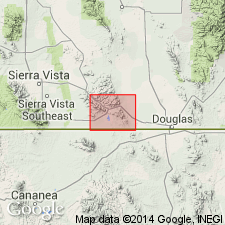
- Usage in publication:
-
- Dragoon quartzite
- Modifications:
-
- Original reference
- Dominant lithology:
-
- Quartzite
- AAPG geologic province:
-
- Pedregosa basin
Summary:
Pg. 696-715. Dragoon quartzite. Consists of 400 feet of sandstones and quartzite. Underlain by limestone in Dragoon Mountains and overlain by limestone containing Middle Devonian fossils. In Mule Mountains it underlies Devonian limestone and overlies a bed of porphyritic andesite which rests on schists.
Source: US geologic names lexicon (USGS Bull. 896, p. 630).

- Usage in publication:
-
- Dragoon quartzite†
- Modifications:
-
- Abandoned
- AAPG geologic province:
-
- Pedregosa basin
Summary:
Pg. 28. †Dragoon quartzite. It is probable the so-called Dragoon quartzites of Dragoon and Mule Mountains are stratigraphically the same, but Dumble not only omitted to establish this correlation, but has rather obscured it by several statements revealing misconceptions of geologic structure not altogether surprising considering the rapid character of his reconnaissance. If, for example, the two Dragoon quartzites are properly correlated by Dumble, the reported occurrence of 40 feet of limestone underlying the quartzite in Dragoon Mountains seems, in light of work in Mule Mountains, to require confirmation, since in latter range the so-called Dragoon quartzite rests with a basal conglomerate upon pre-Cambrian schists. As base of these schists is nowhere exposed, and as the only granitic rocks in Bisbee quadrangle are post-Carboniferous. Dumble's statement that the schists have a thickness of only 300 feet and rest upon granite is misleading. It was at first intended to use in this report the term Dragoon quartzite for the basal sedimentary formation of Bisbee quadrangle, but for reasons just indicated this name has been reluctantly abandoned and that of Bolsa quartzite adopted in its stead.
Source: US geologic names lexicon (USGS Bull. 896, p. 630).
For more information, please contact Nancy Stamm, Geologic Names Committee Secretary.
Asterisk (*) indicates published by U.S. Geological Survey authors.
"No current usage" (†) implies that a name has been abandoned or has fallen into disuse. Former usage and, if known, replacement name given in parentheses ( ).
Slash (/) indicates name conflicts with nomenclatural guidelines (CSN, 1933; ACSN, 1961, 1970; NACSN, 1983, 2005, 2021). May be explained within brackets ([ ]).

